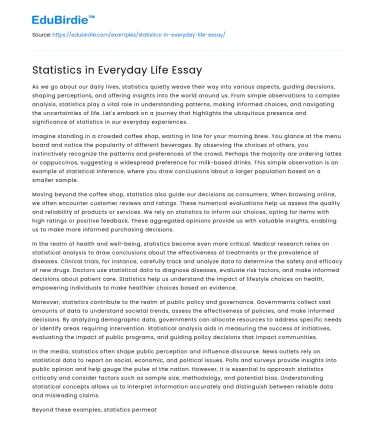As we go about our daily lives, statistics quietly weave their way into various aspects, guiding decisions, shaping perceptions, and offering insights into the world around us. From simple observations to complex analysis, statistics play a vital role in understanding patterns, making informed choices, and navigating the uncertainties of life. Let's embark on a journey that highlights the ubiquitous presence and significance of statistics in our everyday experiences.
Imagine standing in a crowded coffee shop, waiting in line for your morning brew. You glance at the menu board and notice the popularity of different beverages. By observing the choices of others, you instinctively recognize the patterns and preferences of the crowd. Perhaps the majority are ordering lattes or cappuccinos, suggesting a widespread preference for milk-based drinks. This simple observation is an example of statistical inference, where you draw conclusions about a larger population based on a smaller sample.
Save your time!
We can take care of your essay
- Proper editing and formatting
- Free revision, title page, and bibliography
- Flexible prices and money-back guarantee
Moving beyond the coffee shop, statistics also guide our decisions as consumers. When browsing online, we often encounter customer reviews and ratings. These numerical evaluations help us assess the quality and reliability of products or services. We rely on statistics to inform our choices, opting for items with high ratings or positive feedback. These aggregated opinions provide us with valuable insights, enabling us to make more informed purchasing decisions.
In the realm of health and well-being, statistics become even more critical. Medical research relies on statistical analysis to draw conclusions about the effectiveness of treatments or the prevalence of diseases. Clinical trials, for instance, carefully track and analyze data to determine the safety and efficacy of new drugs. Doctors use statistical data to diagnose diseases, evaluate risk factors, and make informed decisions about patient care. Statistics help us understand the impact of lifestyle choices on health, empowering individuals to make healthier choices based on evidence.
Moreover, statistics contribute to the realm of public policy and governance. Governments collect vast amounts of data to understand societal trends, assess the effectiveness of policies, and make informed decisions. By analyzing demographic data, governments can allocate resources to address specific needs or identify areas requiring intervention. Statistical analysis aids in measuring the success of initiatives, evaluating the impact of public programs, and guiding policy decisions that impact communities.
In the media, statistics often shape public perception and influence discourse. News outlets rely on statistical data to report on social, economic, and political issues. Polls and surveys provide insights into public opinion and help gauge the pulse of the nation. However, it is essential to approach statistics critically and consider factors such as sample size, methodology, and potential bias. Understanding statistical concepts allows us to interpret information accurately and distinguish between reliable data and misleading claims.
Beyond these examples, statistics permeate countless other areas of our lives. From sports and entertainment to finance and economics, statistics provide a framework for understanding and evaluating the world around us. They enable us to measure progress, identify trends, and make predictions about the future.
In conclusion, statistics play a pervasive role in our everyday lives, often operating behind the scenes, shaping our decisions, and informing our perceptions. Whether we realize it or not, we encounter statistical concepts in various contexts, from consumer choices to healthcare decisions, public policy, and media reporting. Understanding the power of statistics allows us to navigate the complexities of the world with greater insight and make more informed choices. So, the next time you observe a graph, encounter survey results, or analyze data, remember the profound impact of statistics on our understanding of the world and our ability to make sense of the information around us.






 Stuck on your essay?
Stuck on your essay?

